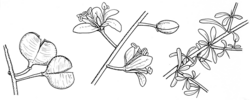Common name: Blackthorn, Boxthorn, Sweet Bursaria, Kurwan (D'harawal)
Bursaria spinosa Cav. APNI* 
Description: Shrub or small to medium tree to 10 m high; branches almost glabrous, usually spinose.
Adult leaves often clustered at nodes, becoming alternate, linear to narrowly ovate, to obovate or cuneate, usually (4-) 20–43 mm long, 3–12 mm wide; margin thick, slightly down-turned; apex rounded to slightly notched with mucro; leaf surface often glabrous or almost so, or lower surface hairy.
Inflorescences terminal pyramidal panicles 10–25 cm long, or occasionally in axillary clusters. Flowers numerous, aromatic, bisexual. Sepals c. 1 mm long, caducous or persistent to anthesis. Petals usually 3–6 mm long, 1–2 mm wide, white or cream-coloured.
Capsule flattened, purse-like, 4–10 mm long, 6–9 mm wide; base slightly stalked; apex truncate or notched, style persistent.
Flowering: throughout year, but chiefly in summer.
Distribution and occurrence: Widespread and common throughout the State and all ofther states, except Western Australia and Northern Territory.. Grows in dry to wet sclerophyll forest, often on non-siliceous soils; sometimes a weed on cleared land.
NSW subdivisions: NC, CC, SC, NT, CT, ST, NWS, CWS, SWS, NWP, SWP
Other Australian states: Qld Vic. Tas. S.A.
Two subspecies are recognised, namely, Bursaria spinosa subsp. spinosa and subsp. lasiophylla.
Text by B.J. Conn & R.G. Coveny
Taxon concept: L.W Cayzer, M.D. Crisp & I.R.H. Telford (1999)
| | Key to the subspecies | |
| 1 | Erect tree or shrub, 5–10 m high; hairs on new shoots and abaxial surface of leaves usually not persisting with age; adult leaves 23–43 mm long, 5–9 mm wide; petals 4–6 mm long | subsp. spinosa |
| Multi-stemmed shrub usually less than 5 m high; hairs moderately dense, appressed to shoots, abaxial surface of leaves, and ovary persistent; adult leaves 20–35 mm long, 7–12 mm wide; petals up to 4 mm long | subsp. lasiophylla |
APNI* Provides a link to the Australian Plant Name Index (hosted by the Australian National Botanic Gardens) for comprehensive bibliographic data
***The AVH map option provides a detailed interactive Australia wide distribution map drawn from collections held by all major Australian herbaria participating in the Australian Virtual Herbarium project.
|


